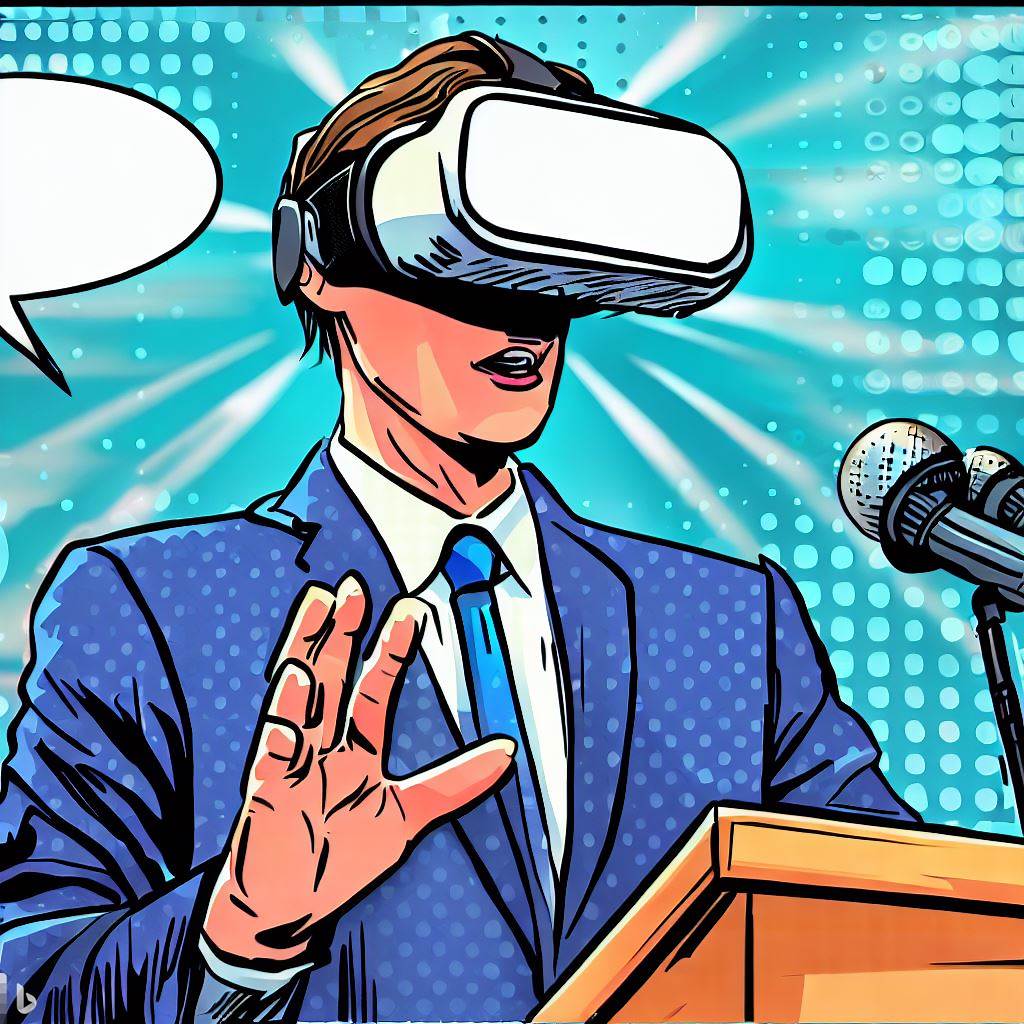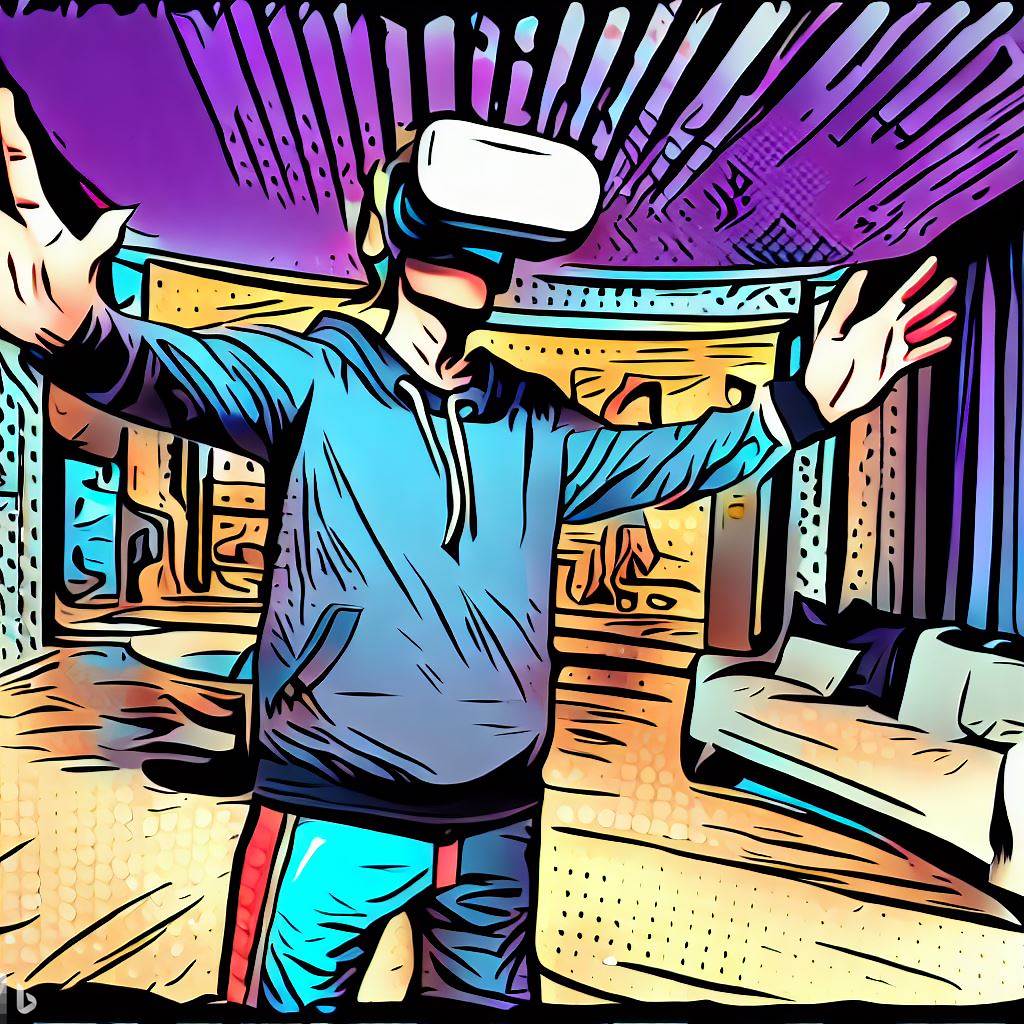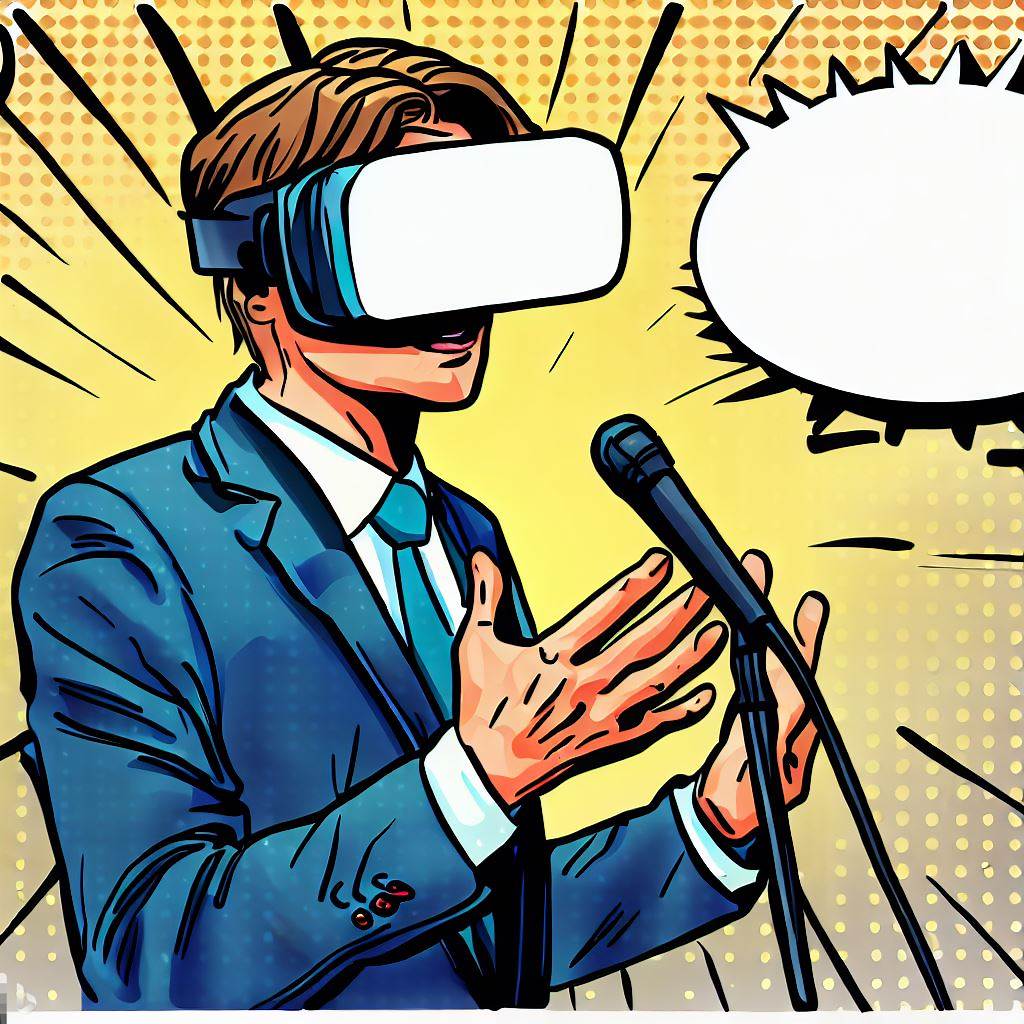Let me guess, you’re here because public speaking gives you the jitters, right? Or maybe you’re already a pro who wants to take their skills to the next level? Either way, I’ve got you covered! Welcome to Mastering Public Speaking with VR: A Comprehensive Guide, your one-stop shop for transforming yourself into a confident, captivating speaker. Trust me, by the end of this journey, you’ll be acing presentations and speeches like a rockstar!
🎯 In this guide, we’ll dive into: 🎯
- The science behind why public speaking can be so nerve-wracking
- How VR is revolutionizing the way we conquer our fears
- The best VR applications and tools for mastering public speaking
- Step-by-step instructions for setting up and using VR to practice your speeches
- Tips, tricks, and techniques for delivering an unforgettable talk
So, are you ready to unlock the power of VR and conquer your public speaking fears once and for all? Let’s dive in and get started on your journey towards becoming the ultimate public speaker! 🚀
Understanding Public Speaking Anxiety

Public speaking anxiety, or glossophobia, is a common fear that plagues countless individuals. In this section, we’ll break down the psychology behind this fear, explore why it affects so many of us, and provide some tips on how to manage anxiety triggers.
The Psychology of Public Speaking Anxiety
To truly conquer our fears, we must first understand their roots. Let’s take a closer look at the psychological factors that contribute to public speaking anxiety.
- Fear of the Unknown For many, public speaking is an unfamiliar experience. The unknown can be daunting, and our minds often fill in the gaps with worst-case scenarios. This causes our anxiety to skyrocket.
- Fear of Being Judged When we’re in the spotlight, we become hyper-aware of every little detail, fearing that our audience will notice and judge our mistakes. This heightened self-awareness can make it difficult to focus on our message.
- Fear of Failure The pressure to perform well can be overwhelming. We worry about making mistakes, losing our train of thought, or being unable to answer questions, which can lead to a debilitating fear of failure.
Recognizing and Managing Anxiety Triggers
To overcome public speaking anxiety, it’s essential to identify and manage the triggers that exacerbate our fears. Here are some tips to help you do just that:
- Become Familiar with the Unknown
- Research: Learn as much as you can about your audience, the venue, and the subject matter. This will help you feel more prepared and confident.
- Visualize: Imagine yourself giving a successful speech in the setting you’ll be speaking in. Visualization can help reduce anxiety and set you up for success.
- Reframe Your Perception of Being Judged
- Acknowledge Imperfections: No one is perfect, and most audiences are forgiving. Embrace your imperfections and focus on delivering value.
- Build Rapport: Connect with your audience by sharing personal stories or experiences, making eye contact, and showing genuine interest in their reactions. This can help create a more supportive atmosphere.
- Tackle Your Fear of Failure
- Practice, Practice, Practice: Rehearse your speech multiple times, record yourself, and ask for feedback. This will help you become more comfortable and reduce the chances of making mistakes.
- Develop a Recovery Plan: Prepare a backup plan in case something goes wrong, like having a printed copy of your speech or strategies to regain your composure. Knowing you have a safety net can reduce anxiety.
By understanding the psychology behind public speaking anxiety and learning how to manage your triggers, you’re already taking a significant step towards overcoming your fears. In the next section, we’ll explore how Virtual Reality (VR) can further revolutionize your journey to becoming a master public speaker.
The Power of Virtual Reality

Virtual Reality (VR) has come a long way since its inception, and its applications extend far beyond gaming and entertainment. In this section, we’ll explore the transformative impact of VR on learning and personal development, and discover how it can help you conquer your public speaking fears.
The Magic of VR in Learning and Development
VR is an immersive technology that can transport users into a virtual world, simulating real-life experiences. This unique characteristic has made VR a powerful tool in the realm of learning and development. Here’s why:
- Safe and Controlled Environment VR creates a safe space for users to practice and learn without the risks and consequences associated with real-world situations. This allows for trial and error, fostering confidence and skill development.
- Realistic Simulations VR can replicate real-life scenarios with astonishing accuracy, allowing users to gain valuable experience and hone their skills in a lifelike environment. This can lead to better performance and increased self-assurance in real-world situations.
- Customizable Experiences VR provides a flexible platform for tailoring experiences to meet individual needs. Users can adjust difficulty levels, environments, and scenarios to create personalized learning experiences that cater to their unique goals.
Real-World Examples of VR in Personal Development
Many industries have already embraced VR as a valuable tool for learning and personal growth. Here are some examples of how VR has been utilized for self-improvement:
- Medical Training: VR is used to simulate surgeries, allowing medical professionals to practice complex procedures in a risk-free environment.
- Military Training: Soldiers can rehearse high-stakes missions and develop critical skills in realistic, immersive simulations.
- Phobia Treatment: VR exposure therapy has proven effective in treating various phobias, such as fear of heights, by gradually exposing individuals to their fears in a controlled environment.
Harnessing VR for Public Speaking Mastery
Given the transformative impact of VR on learning and personal development, it’s no surprise that VR has emerged as a powerful tool for conquering public speaking anxiety. By simulating realistic speaking environments and providing a safe space to practice, VR can help you:
- Gain experience speaking in front of different audience sizes and demographics
- Develop confidence by rehearsing in a judgment-free zone
- Experiment with different speaking styles, techniques, and scenarios
- Receive instant feedback on your performance through built-in features
As you can see, VR holds immense potential for those seeking to master public speaking. In the next section, we’ll dive into the best VR applications and tools that can help you on your journey towards becoming a captivating speaker.
Top 5 VR Apps for Public Speaking Mastery
With the growing popularity of VR as a tool for personal development, several applications have been designed specifically for public speaking training. In this section, we’ll explore some of the best VR apps that can help you overcome your fears and develop your public speaking skills.
1. Speech Trainer (Oculus Rift, Oculus Quest)

Speech Trainer is an excellent VR application that focuses on improving public speaking skills by offering realistic environments and an AI-generated audience.
Key Features:
- Customizable audience size, demographics, and reactions
- Real-time feedback on your speech pace, filler words, and eye contact
- A variety of environments, including conference rooms and stages
2. VirtualSpeech (Oculus Rift, Oculus Quest, HTC Vive, Google Daydream)

VirtualSpeech combines VR with traditional e-learning courses to provide a comprehensive public speaking training program. The app offers a range of scenarios, environments, and features designed to improve your skills.
Key Features:
- Immersive environments, such as boardrooms, lecture halls, and interview settings
- Customizable audience behavior, size, and noise level
- Real-time feedback on speech delivery, eye contact, and filler words
- Integration with e-learning courses for a blended learning experience
3. Ovation (Oculus Rift, HTC Vive)

Ovation is a professional VR public speaking training platform designed for both beginners and experienced speakers. The app provides realistic environments, audience feedback, and a wide range of tools to help you refine your skills.
Key Features:
- Highly detailed and diverse environments, such as conference halls and business meetings
- AI-generated audience with customizable size, demographics, and reactions
- Real-time speech analytics, including pacing, volume, and filler words
- In-app teleprompter and integrated slide presentations
5. Fearless (Oculus Rift, HTC Vive)

Fearless is a VR application specifically designed to help users overcome various phobias, including the fear of public speaking. The app uses exposure therapy techniques to gradually expose users to their fears in a controlled environment.
Key Features:
- Exposure therapy-based scenarios for public speaking and other common phobias
- Gradual increase in difficulty levels to build confidence and resilience
- Guided techniques and strategies for managing anxiety and fear
Each of these VR applications offers unique features and experiences tailored to public speaking training. Take the time to explore them and find the one that best suits your needs and preferences. In the next section, we’ll guide you through setting up your VR space and getting started on your journey to mastering public speaking.
Setting Up Your VR Space

Before you can dive into the world of VR public speaking training, you’ll need to set up your VR space. In this section, we’ll provide step-by-step instructions to help you create the perfect VR environment for practicing your speeches and presentations.
Step 1: Choose Your VR Headset
The first step is to choose a VR headset that is compatible with your chosen public speaking app. Popular options include the Oculus Rift, Oculus Quest, HTC Vive, etc. Be sure to research the features and specifications of each headset to find the one that best suits your needs and budget.
Step 2: Prepare Your Physical Space
To ensure a safe and comfortable VR experience, you’ll need to prepare a dedicated space for your VR activities. Here are some tips for setting up your physical space:
- Clear a minimum area of 6.5 x 6.5 feet (2 x 2 meters) to allow for free movement
- Remove any obstacles or tripping hazards, such as furniture or cords
- Make sure the floor is even and non-slippery
- Ensure there is adequate lighting, but avoid direct sunlight, which can damage your headset’s sensors
Step 3: Set Up Your VR Headset and Sensors
Now that your physical space is ready, it’s time to set up your VR headset and sensors. Follow the manufacturer’s instructions for your specific headset, which should include guidance on:
- Connecting the headset to your computer or gaming console (if required)
- Positioning and calibrating the sensors for optimal tracking
- Adjusting the headset for a comfortable and secure fit
- Installing any necessary software or drivers
Step 4: Install Your Public Speaking App
With your headset and sensors set up, you can now install your chosen public speaking app. Depending on your headset, you may need to download the app from the manufacturer’s app store or through a third-party platform like Steam. Follow the app’s installation instructions and ensure your headset is compatible with the software.
Step 5: Familiarize Yourself with the VR Controls
Before diving into your public speaking training, take some time to familiarize yourself with the VR controls. This may include learning how to:
- Navigate menus and select options
- Adjust settings, such as audience size and environment
- Use in-app tools, like teleprompters or analytics features
- Exit the app or return to the main menu
Step 6: Troubleshooting Common VR Issues
Finally, it’s essential to be prepared for any potential issues that may arise during your VR training sessions. Common problems and their solutions include:
- Motion Sickness: If you experience motion sickness, take breaks, and gradually increase your time in VR. Adjusting the headset’s interpupillary distance (IPD) may also help.
- Headset Fogging: To prevent fogging, allow your headset to acclimate to room temperature before use. Anti-fog wipes or sprays can also be helpful.
- Tracking Issues: If your sensors are not tracking your movements accurately, try adjusting their positioning or recalibrating them according to the manufacturer’s instructions.
Articles on motion sickness:
– Feeling Dizzy After VR? Understand Why and How to Prevent It
– Can Virtual Reality Make You Sick?
– How to Get Over VR Motion Sickness: Tips and Tricks
– How Long Does Virtual Reality Sickness Last?
With your VR space set up and ready to go, you can now begin practicing and perfecting your public speaking skills in a safe, controlled environment. In the next section, we’ll share tips and techniques for crafting an engaging speech and rehearsing it effectively using your new VR tools.
Practicing and Perfecting Your Speech

Now that your VR space is set up, it’s time to focus on practicing and perfecting your speech. In this section, we’ll share tips and techniques for crafting an engaging speech, rehearsing effectively, and making the most of your VR training sessions.
Crafting an Engaging Speech
An essential aspect of public speaking is delivering an engaging and memorable speech. Here are some tips for creating a compelling presentation:
- Know Your Audience: Tailor your speech to the interests, knowledge level, and expectations of your audience. This will help you establish a connection and keep them engaged.
- Structure Your Speech: Organize your speech into a clear and logical structure, including an introduction, main points, and a conclusion. This will help your audience follow your thoughts and make your message more memorable.
- Tell Stories: Use personal anecdotes, case studies, or examples to illustrate your points. Stories can make complex concepts easier to understand and more relatable for your audience.
- Incorporate Visual Aids: Visual aids, such as slides or props, can help clarify your points, maintain audience interest, and provide a break from continuous speaking.
Rehearsing Your Speech in VR
Once your speech is crafted, it’s time to start rehearsing in your VR environment. Here are some tips to help you make the most of your practice sessions:
- Experiment with Different Scenarios: Take advantage of the customizable settings in your VR app to practice speaking in a variety of environments and to diverse audiences. This will help you build confidence and adaptability.
- Focus on Nonverbal Communication: Use the VR environment to practice your body language, posture, gestures, and facial expressions. Nonverbal communication is a crucial aspect of public speaking and can help convey your message more effectively.
- Record Your Sessions: Many VR apps allow you to record your practice sessions, enabling you to review your performance, identify areas for improvement, and track your progress over time.
- Incorporate Feedback: Utilize the real-time feedback features in your VR app to identify areas where you may need to adjust your pace, tone, or eye contact. Be open to critique and committed to making improvements.
Maximizing the Benefits of VR Training
To get the most out of your VR public speaking training, follow these best practices:
- Establish a Consistent Practice Routine: Schedule regular practice sessions and commit to a consistent routine. This will help you build your skills more effectively and develop good public speaking habits.
- Set Specific Goals: Establish clear, measurable goals for your public speaking journey. This could include reducing filler words, improving eye contact, or increasing audience engagement. Track your progress toward these goals using your VR app’s analytics features.
- Combine VR with Traditional Training Methods: While VR is a powerful tool, it’s essential to combine it with traditional public speaking training techniques, such as joining a local Toastmasters club or attending workshops.
- Stay Patient and Persistent: Developing excellent public speaking skills takes time and effort. Be patient with yourself and stay committed to your practice, even when progress seems slow.
By following these tips and techniques, you’ll be well on your way to becoming a master public speaker. Remember, practice makes perfect, and with the help of VR technology, you have a unique opportunity to hone your skills in a safe and supportive environment. So, put on your VR headset and start practicing—your audience awaits!
Delivering a Talk They’ll Never Forget

After mastering the art of public speaking through VR practice and traditional methods, it’s time to focus on delivering a talk your audience will never forget. In this section, we’ll share strategies and techniques for creating a memorable and impactful presentation that leaves a lasting impression.
Start Strong with a Powerful Opening
The first few minutes of your speech are crucial for capturing your audience’s attention and setting the tone for the rest of your talk. Here’s how to create a powerful opening:
- Begin with a Quote: Starting with a thought-provoking or inspirational quote can grab your audience’s attention and set the stage for your main message.
- Share a Personal Story: A personal anecdote can create an emotional connection with your audience and demonstrate your credibility on the subject.
- Ask a Question: Engaging your audience with a rhetorical or thought-provoking question can pique their curiosity and encourage active listening.
Engage Your Audience Throughout Your Talk
Keeping your audience engaged is key to delivering a memorable talk. Try these techniques to maintain their interest and participation:
- Use Strategic Pauses: Well-placed pauses can create suspense, emphasize key points, and give your audience time to digest your message.
- Vary Your Tone and Pace: Adjusting your vocal delivery can keep your audience’s attention and make your speech more dynamic and engaging.
- Employ Humor: Lighten the mood and build rapport with your audience by incorporating humor, but make sure it’s appropriate and relevant to your topic.
Connect with Your Audience on a Personal Level
Connecting with your audience on an emotional level can make your speech more memorable and impactful. Here are some ways to create a personal connection:
- Use Eye Contact: Make an effort to look at individual audience members throughout your talk, which can help you establish a more personal connection and convey sincerity.
- Show Empathy: Demonstrate understanding and compassion for your audience’s concerns or challenges, and make your message relatable to their lives.
- Invite Participation: Encourage audience interaction through questions, polls, or activities, which can create a more engaging and memorable experience.
Leave a Lasting Impression with a Strong Conclusion
The final moments of your speech are your chance to drive home your main message and leave a lasting impression. Consider these strategies for a powerful conclusion:
- End with a Call-to-Action: Encourage your audience to take action or make a change based on the insights you’ve shared.
- Summarize Your Key Points: Reinforce your message by briefly summarizing your main points and their significance.
- Finish with a Powerful Statement: Leave your audience with a thought-provoking or inspiring closing statement that ties back to your opening and reinforces your message.
By combining these strategies with your well-practiced public speaking skills, you’ll be well-equipped to deliver a talk your audience will never forget. Remember, your journey to becoming a captivating speaker is an ongoing process, and with each speech you deliver, you’ll continue to learn, grow, and inspire others.
Conclusion
Mastering public speaking is a journey that requires consistent practice, dedication, and the willingness to learn from your experiences. By leveraging the power of virtual reality, you can immerse yourself in realistic environments and build your confidence in a safe and supportive space. Combine this cutting-edge technology with traditional public speaking training methods and our tips for crafting engaging speeches, and you’ll be well on your way to delivering talks that leave a lasting impression.
As you continue to develop your skills, remember that growth comes from persistence and a commitment to self-improvement. Embrace the opportunities that VR provides and stay open to feedback as you progress. Soon, you’ll find yourself captivating audiences with your words and leaving a mark as a speaker they’ll never forget.
Thank you for reading!




